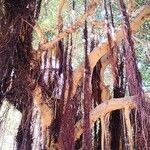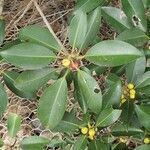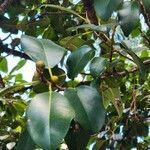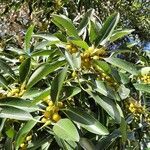Tree to 50 m high, with spreading crown [usually a strangler fig, to 30 m high, fide Cooper & Cooper (2004)]; trunk to 2 m diam.; young twigs ferruginous-pubescent. Leaves alternate; lamina elliptic to ovate, rarely slightly obovate, 7–11 cm long, 3.5–7.5 cm wide, cuneate to subrotund at base, obtuse to slightly acute at apex, ferruginous-pubescent beneath; lateral veins 10–13 pairs, prominent; petiole 2–4 cm long; stipules 4–7 cm long. Figs globular, to 1.5 cm diam., prominently warted; ostiole 3-or 4-radiate, to 3 mm diam., slightly raised; basal bracts 3, to 2 cm long, ferruginous-pubescent; peduncle 0.5–1 cm long often dilated at apex, puberulous. Male and female flowers interspersed, pedicellate; pedicels c. 1 mm long; tepals 3. [The above description of Ficus obliqua from Chew (1989: 42–43) requires revision to possibly include F. baileyana and elements of formerly accepted F. obliqua var. petiolaris and F. platypoda var. angustata; more recent treatments of F. rubiginosa are provided by Cooper & Cooper (2004: 327), Ficus rubiginosa f. glabrescens and F. rubiginoa f. rubiginosa, in Australian Tropical Rainforest Plants Edn 8 (2020), and Ficus rubiginosa, in New South Wales Flora Online (accessed 13 January 2022)-Editor, 13 January 2022.] Description of F. baileyana from Chew (1989: 41–42): Tree to 20 m high with spreading crown. Leaves with lamina usually elliptic, rarely ovate, 12–15 cm long, 6.5–7.5 cm wide, subrotund at base, acute, rarely bluntly acuminate at apex, ferruginous-pubescent beneath; primary lateral veins 13–16 pairs, slightly more prominent than the secondary ones; petiole 5–7 cm long, pubescent; stipules to 5 cm long, densely ferruginous-pubescent. Figs paired, lenticellate, ferruginous-pubescent, oblong, to 2 cm long and 1.5 cm wide; ostiole minute, very slightly raised; basal bracts sometimes broadly ovate, ferruginous-pubescent; peduncle 1–1.5 cm long, c. 5 mm diam., pubescent. Male and female flowers dispersed, shortly pedicellate; tepals 4.
More
A fig. It is a large bush or small tree. It is evergreen. It grows 9-20 m tall. It spreads almost as wide. The main trunk is buttressed. It can have aerial roots. The bark is pale yellowish-brown. The young shoots are finely hairy. The leaves are shiny deep green on top and downy and rust coloured underneath. They are alternate. The leaves are 6-12 cm long and 3-5 cm wide. The leaf stalks are 2-5 cm long. The fruit occur in pairs in the axils of leaves. They are round and yellow but turn deep red. They are 1.5-2 cm across. White sap comes out of broken twigs and branches,
Evergreen, monoecious, small to large tree, often starting life as an epiphyte. Young stems finely hairy, becoming glabrous. Lvs ± glabrous above, sparsely to densely clothed in fine reddish hairs below, not lobed, entire, ovate-elliptic to obovate, obtuse at base, acute to obtuse at apex, (4)-6-12 cm long; lateral veins not prominently raised; petiole < blade; stipules 2 per node, densely hairy, triangular, caducous. Infl. green with rusty hairs, globose, shortly pedunculate. Syncarp deep yellow to dull red, 12-20 mm diam.; achenes irregularly ovoid, c. 1.5 mm long.









